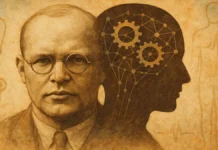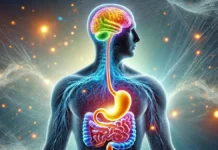Introduction
In the twists and turns of the human experience, the often-restrained emotional embrace is revealed through a little-known ballet of muscular tensions. Our nervous system, like an invisible conductor, coordinates this bodily symphony, skillfully restricting the emergence and expression of emotions. Physical manifestations, discreet but significant, such as tension in the jaw, constriction of the throat, shortness of breath, chest rigidity and clenching of the fists, weave a silent narrative of this intimate dance between the mind and the body.
1. Unexpected Actors: The stage is populated by unexpected actors – our muscles, docile puppets in the hands of the nervous system. These muscles, often neglected in their emotional role, transform into silent messengers of internal torments, revealing the subtle framework of held emotions.
2. Muscle Tension As Language: Muscle tension becomes the body language through which the mind communicates its emotional reflections. The clenched jaw tells a story of emotional restraint, the tight throat evokes suppressed feelings, while shortness of breath and rigid chest reveal inner battles.
3. Sensory Symphony: A sensory symphony of the body, this subtle dance highlights the deep connection between emotion and physics. Each note of muscular tension resonates as a response to the emotional score, creating harmony or chaos in the bodily landscape.
4. An Invisible World: The invisible becomes visible through these muscular manifestations. Where emotions might remain hidden, muscles become faithful storytellers, revealing the often unarticulated internal chapters of our emotional journey.
5. An Exploration to Come: This exploration of emotional depths through the lens of muscle opens the way to a deeper understanding of the complex interaction between mind and body. These bodily manifestations, while often overlooked, form a woven web of sensation, providing fertile ground for continued exploration of the mysteries of the human experience.
Together, let’s dive into this exploration where muscles become the brush with which the mind paints its emotional states, and where bodily dance reveals the hidden secrets of our inner world.
The Invisible Work of the Nervous System
The muscles, far from operating independently, are the skillful puppets of an invisible maestro: the nervous system. This nervous orchestration, often unconscious, modulates muscular tensions, creating a complex ballet of movements in reaction to the stimuli of daily life.
1. Nervous Governance: Muscles are not independent actors. It is the nervous system that holds the reins of muscular tension, adjusting invisible wires in response to sensory and emotional signals.
2. Unconscious Postural Adjustment: Unconsciously, the nervous system adjusts the tension of specific muscle groups based on postures held for prolonged periods. Whether you are sitting with your knees hyperextended or in an uncomfortable position, the nervous system modulates tensions to maintain balance and stability.
3. Immediate Traumatic Response: Physical trauma to the spine triggers an immediate response from the nervous system. It tightens the muscles to protect them, preventing further damage. This reflex response is easily observed, but it is different for emotional trauma.
4. Hidden Emotional Trauma: Recognizing how emotional trauma can contribute to prolonged muscle contraction is as complex as deciphering subtle sheet music. Repressed emotions, often invisible to conscious awareness, leave an imprint in the muscles, creating lasting tensions that influence posture and mobility.
5. Invisible Dance: Like an invisible dancer guiding the steps of a secret choreography, the nervous system directs muscular tension according to external and internal stimuli. This dance, although silent, can profoundly influence our physical and emotional well-being.
In short, the role of the nervous system in the modulation of muscular tensions reveals a complex interaction between the physical and the emotional. Understanding this invisible symphony offers valuable insight into how our bodies respond to the multiple nuances of life, shaping our bodily experience over time.
Harmony Between Muscles and Emotions
Even after emotions have withdrawn from awareness, their imprint remains in the body, weaving disrupted patterns of movement. The muscles, particularly the psoas, become the physical receptacle for these emotional residues, influencing our physical and mental well-being.
1. Neurological Persistence: The neurological response to an emotion, even past, persists in the body. This response develops into dysfunctional movement patterns, altering the way muscles interact and contract.
2. Psoas: The psoas, often blamed for lower back pain, turns out to be a key player in this relationship between muscles and emotions. It reacts not only to physical demands but also to emotional states, tensing up in response to situations perceived as threatening or stressful.
3. Emotional Expression: The muscles, particularly the psoas, become a form of expression for unexpressed emotions. Muscular tension can thus be the silent language of the body, communicating buried feelings that consciousness may have chosen to ignore.
4. Lower Back Pain: Lower back pain, often attributed to physical problems, can also be the result of accumulated emotional tension. The psoas, by contracting for a prolonged period, can trigger pain that transcends the simple physical dimension.
5. Response to Emotional Threats: The muscles, particularly the psoas, react to emotional threats in the same way they would react to a physical threat. This reactivity can become an automatic response, influencing our posture, our movements and even our breathing.
6. Emotional Release: Becoming aware of this connection between muscles and emotions offers an opportunity to release accumulated tensions. Practices such as targeted muscle release, yoga, or meditation can help relax the psoas, opening a path to emotional release and physical relief.
In short, the relationship between muscles, particularly the psoas, and emotions transcends simple physical function. Muscles become silent witnesses to our emotional landscape, providing an opportunity for deep understanding and much-needed release. Taking care of our muscles also means taking care of our emotional well-being.
Breathing as a Revealer of Deep Emotions
Breathing, often neglected in its role, turns out to be a powerful indicator of deep emotions and muscular tensions. The essential connection between tight muscles, particularly the psoas, and emotions lies in the respiratory-related sensory information that the nervous system receives. Most people are unaware that the contraction and relaxation of the diaphragm, a dome-shaped muscle beneath the lungs, governs the entry and exit of air from the lungs. This respiratory orchestration extends its influence beyond simple pulmonary function, creating a significant link between breathing and the deep muscles of the trunk, particularly the psoas.
1. Governance of the Diaphragm: The diaphragm, located under the lungs, is the conductor of breathing. Its regular contraction and relaxation orchestrate the harmonious movement of air in the lungs. This process is often unconscious, but it is of capital importance in the management of emotions. Breathing thus becomes a direct reflection of emotional states.
2. The Psoas, Emotional Bridge: The psoas, this muscle rooted in the lumbar vertebrae, plays the role of an emotional bridge. By passing through the diaphragm, the psoas becomes an intermediary between breathing and deep emotions. Their abnormal tension may be a sign of repressed emotions or unresolved stress, creating a physical manifestation of the emotional charge.
3. Respiratory Interconnection: The symbiosis between the diaphragm and psoas establishes a significant respiratory interconnection. Variations in breathing pattern, such as short, choppy breaths, can indicate emotional imbalance. Conversely, deep, calm breathing signals a balanced emotional state.
4. Sensory Response: The nervous system senses variations in breathing and decodes this information into emotional responses. The muscles, particularly the psoas, react accordingly. Rapid breathing triggers a fight or flight response, inducing muscle contraction. Awareness of these sensory responses offers a pathway to releasing pent-up emotions.
In conclusion, breathing acts as a revealer of deep emotions, highlighting muscular tension, particularly that of the psoas. Becoming aware of this respiratory interconnection offers an opportunity to release buried emotions and restore emotional balance. Breathing thus becomes a precious tool for exploring and transforming the deepest emotional dimensions of our being.
The Deep Influence of Breathing on Movements and Mobility
The fundamental connection between tight muscles, particularly the psoas, and emotions lies in the respiratory-related sensory information that the nervous system receives. Most are unaware that the contraction and relaxation of the diaphragm, a dome-shaped muscle beneath the lungs, governs the entry and exit of air from the lungs. The psoas, originating from the lumbar vertebrae, passes through the diaphragm, creating an interconnection between breathing and the deep muscles of the trunk.
The intimate connection between breathing and body movements is often underestimated. The way we breathe can have a significant impact on muscle function, posture and mobility. In particular, abnormal tension in the psoas and short breaths can impair movement function, creating a critical link between breathing, emotional health and resilience.
1. Psoas and Movement Function: The psoas, a muscle deeply rooted in the lumbar region, plays a crucial role in trunk mobility and stability. Abnormal tension in the psoas, often related to suppressed emotions, can lead to muscle imbalances, affecting posture and movement function. Mindful breathing is emerging as a powerful way to regulate this tension and improve psoas function.
2. Short Breaths and Impaired Mobility: Short breaths, often associated with stress and pent-up emotions, can contribute to impaired mobility. Shallow, rapid inhalations activate the sympathetic nervous system, inducing a fight or flight response that also manifests at the muscular level. By adopting conscious breathing strategies, it is possible to restore healthy breathing patterns, promoting optimal mobility.
3. Emotional Health Barometer: Breathing becomes a barometer of emotional health and resilience. By observing how the breath responds in different situations, one can gain valuable clues about the underlying emotional state. Calm, deep breaths signal a balanced emotional response, while short, choppy breaths may indicate stress or unresolved emotional tension.
4. Conscious Breathing to Improve Mobility: Integrating conscious breathing into the daily routine becomes essential to improve mobility. Regular deep, slow breathing practices help release muscle tension, particularly in the psoas, creating a path to smooth, balanced mobility. Breath awareness during exercise and daily activities strengthens the connection between breathing, emotions and movement.
In conclusion, recognizing the impact of breathing on movement provides a valuable opportunity to improve emotional health and physical mobility. Conscious breathing thus becomes a powerful tool for balancing body and mind, promoting a more dynamic and resilient life.
Response of the Sympathetic Nervous System: Automatic Adaptation to Stress
Response of the Sympathetic Nervous System: Automatic Adaptation to Stress
When stressed or afraid, the brain triggers an instinctive reaction from the sympathetic nervous system, a response designed to prepare the body for survival. Rooted deep in our nervous system, this reaction has a significant impact on the muscles that control the Center of Mass (COM) or pelvis. This automatic response manifests itself through various physical reactions, a process easily understood when dealing with physical pain. However, it is crucial to recognize that repressed emotions follow the same response pathway.
When a person faces a perceived threat, the sympathetic nervous system kicks into action to prepare the body for three basic responses: flight, fight, or freeze. This rapid activation aims to maximize survival by mobilizing the energy necessary to cope with the stressful situation. The scope of this response encompasses all muscles responsible for coordinating the Center of Mass, a central region of the body essential for mobility.
This automatic reaction of the nervous system has profound implications, not only in situations of immediate danger, but also in the management of repressed emotions. Repressed emotions, often unconscious, follow a similar pattern of physiological response. When emotions are repressed or unexpressed, the brain interprets this as an emotional threat, thereby triggering the same sympathetic nervous system response seen in physical pain.
The muscles surrounding the Center of Mass respond by contracting or freezing, creating protective muscular armor. This automatic reaction can lead to tension in the jaw, throat, chest, and fists, contributing to patterns of prolonged muscle tension. It is crucial to understand that this response is not exclusive to physical pain; it is just as present in managing the emotional aspects of our well-being.
In conclusion, the sympathetic nervous system response is an automatic adaptation of the body to stress, whether of physical or emotional origin. Understanding this automatic response provides important insights into how our bodies deal with repressed emotions. Awareness of this connection between nervous system response and repressed emotions provides opportunities to explore strategies to attenuate these automatic responses, thereby promoting better emotional and physical health.
Breathing Observation: A Powerful Tool for Managing Emotional Pain
Breathing Observation: A Powerful Tool for Managing Emotional Pain
Breathing observation proves to be a valuable tool not only for alleviating physical pain, but also for addressing emotional pain. Techniques that bring awareness to breathing during periods of intense emotion offer an effective way to moderate the sympathetic nervous system’s response.
When emotions reach a peak of intensity, breathing often becomes a direct reflection of the nervous system’s response. Being aware of how we breathe can provide crucial clues about our emotional state. Rapid breathing, frequent sighing or even momentary cessation of breathing are all palpable indicators of activation of the sympathetic nervous system.
Rapid breathing is often associated with times of intense stress or fear, where the body prepares for immediate action. Sighs, on the other hand, can signal an involuntary attempt by the body to regulate oxygen intake, often in response to considerable emotional stress. Cessation of breathing, even briefly, may be a manifestation of nervous system-induced immobility, an attempt to remain very still to minimize the perception of danger.
By integrating awareness of breathing into the management of emotional pain, we can positively influence the response of the sympathetic nervous system. Slow, deep breathing techniques can signal to the brain that the situation is not as threatening as it perceives. This can help defuse the automatic response of flight, fight or freeze.
Breathing thus becomes a means of establishing a conscious link with the emotional and physiological reactions of the body. By developing an attentive relationship with breathing, we can gradually learn to modulate these automatic responses. This paves the way for greater emotional control and more effective management of pain, whether of physical or emotional origin.
In conclusion, breath observation is emerging as an essential tool in the emotional pain management toolbox. By becoming aware of how our body responds through breathing, we gain powerful leverage to positively influence our emotional responses. Breathing thus becomes a valuable ally in the quest for a better understanding and management of pain, offering a path to emotional and physical well-being.
Emotional Liberation Strategies: The Power of Conscious Breathing
When muscular tension and pent-up emotions take over, emotional release strategies can offer significant relief. By focusing on certain qualities of breathing and adopting specific strategies, it is possible to relax tense muscles and release deeply held emotions.
1. Breathing Awareness: The first step towards emotional liberation is to develop awareness of breathing. Observing the rhythm, depth and patterns of breathing offers valuable clues about emotional state. Simply observing the breath, without judgment, creates space to understand and accept present emotions.
2. Deep and Slow Breathing: Deep and slow breathing are powerful allies in emotional liberation. Deliberately slowing breathing sends a signal to the nervous system that the situation is not an immediate threat. This allows the muscles to relax and promotes emotional relaxation.
3. Visualization and Acceptance: By combining breathing with visualization techniques, we can channel blocked emotional energy. Imagining the exhalation carrying away tension and visualizing a calm inner space can facilitate emotional release. Unconditional acceptance of the emotions that arise is also crucial to the liberation process.
4. Liberating Movements: Combining conscious breathing with gentle movements can intensify the process of emotional liberation. Stretching, gentle rocking, and circular movements help release physical tension while encouraging the flow of emotional energy.
5. Creative Expression: Using creative means such as writing, drawing or dancing during mindful breathing practice can provide a powerful outlet. Creative expression allows released emotions to be given tangible form, thus strengthening the process of liberation.
Adopting these emotional release strategies opens a deep neural pathway to emotional release and increased physical comfort. Mindful breathing becomes a powerful guide, allowing you to explore and release emotional tensions that may be buried for a long time. By integrating these strategies into the daily routine, we promote lasting emotional well-being and a deeper connection with ourselves.
Conclusion
Understanding the interplay between emotions, breathing and muscle tension offers valuable insights for improving emotional and physical health. By paying particular attention to breathing and implementing emotional liberation strategies, it becomes possible to unravel the links between repressed emotions and muscular tensions, thus allowing greater emotional freedom and lasting physical well-being.


























